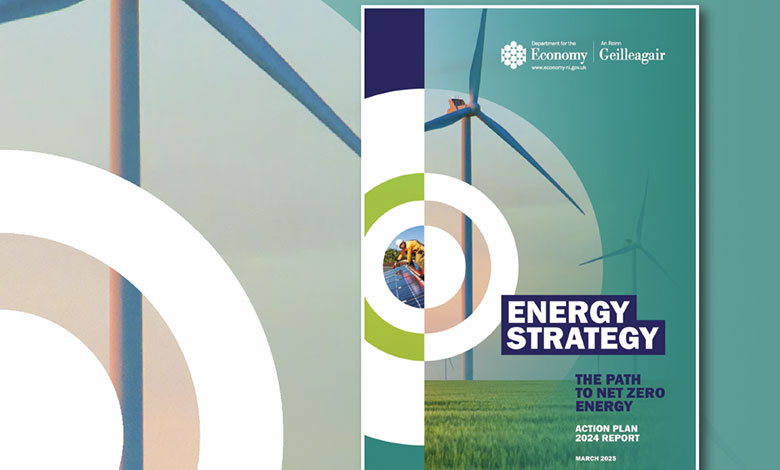
Northern Ireland’s energy: The full story
27th May 2025
Lessons from Iberia
27th May 2025Limited progress on Energy Strategy target delivery

Published alongside Energy Strategy Action Plan 2025 in March 2025, and providing an update on delivery, the Energy Strategy Action Plan Report 2024 indicates that limited progress has been made against targets to date.
Acting as a roadmap to deliver a 56 per cent reduction in energy-related emissions, achieve a target of 80 per cent of electricity consumption from renewable sources by 2030, and deliver net zero emissions across all sectors by 2050, the Energy Strategy: The Path to Net Zero Energy, also contains a commitment to publishing annual progress reports against its associated action plans.
Within the 2024 report, the Department for the Economy (DfE) provides an overview of its Energy Strategy targets and progress to date – including the latest developments in associated initiatives – to deliver against these.
Energy savings
Since the commencement of the Energy Strategy in 2022, cumulative energy savings from buildings and industry have equated to 1 per cent (90.68 GWh) of the energy savings target of 8,000 GWh (a 25 per cent reduction from the baseline) by 2030. Total saved energy in 2024 increased by 0.02 GWh compared with the equivalent figure for 2023 (an increase of 0.02 per cent). A total of four sectors contribute to total energy savings:
- residential;
- business industrial processes;
- public sector; and
- electrical.
Cross-Executive engagement to determine energy savings from initiatives across each of these sectors is ongoing. Meanwhile, alongside the upskilling of the workforce to develop green skills intended to “ensure the appropriate retrofitting of buildings”, the new Fuel Poverty Energy Efficiency Scheme, with a commitment to continue “a whole house approach” will, the Department asserts, contribute to the delivery of energy savings.
Electricity consumption
The Climate Change Act (Northern Ireland) 2022 established a target of at least 80 per cent of electricity consumption being met by a diverse mix of renewable sources by 2030. However, having peaked in the 12-month period to November 2022 (51.6 per cent), between October 2023 and September 2024, 44.5 per cent of total electricity consumption was generated from renewable sources. When compared with the period between October 2022 and September 2023 (47.4), representing a 6 per cent decrease – the second consecutive annual decrease.
Established in February 2024, DfE’s 80 by 30 Working Group (comprising stakeholders from the Department for Infrastructure, the Utility Regulator, and the Strategic Investment Board) engaged energy stakeholders to determine options for rapidly increasing the delivery of onshore renewable energy onto the electricity grid, including via the design of an onshore renewable electricity support scheme (RESS).
Subsequently, the Executive’s Programme for Government committed to “publishing a final design of a Renewable Electricity Support Scheme” in 2025.
Simultaneously, in the Energy Strategy Action Plan 2024, DfE was tasked with identifying areas for potential development of offshore renewable energy. Having undertaken engagement with renewable energy stakeholders, the Department agreed to alter the original action.
Following this, a 12-week consultation on Offshore Renewable Energy Action Plan (OREAP): Consultation on the Strategic Environmental Assessment (SEA), the Environmental Report, and Report to Inform Appropriate Assessment (RIAA) ran until the end of May 2025. DfE asserts that the current process “that we are now working through will ensure sustainable development of offshore renewable energy”.
As a key component of a more efficient and decarbonised electricity system, the use of smart metering is recognised as encouraging “consumption patterns that are more aligned with an energy generation mix that increasingly draws on intermittent renewable power sources”.
A public consultation on the design plan for the rollout of smart electricity meters opened in early October 2024 and concluded in mid-January 2025. Responses from the consultation are intended to inform DfE’s plan to roll out smart meters.
Depending on Executive and Infrastructure Committee approval, the Department for Infrastructure (DfI) is also set to publish a new Regional Strategic Planning Policy which is intended to contribute to renewable energy development and therefore the delivery of the 80 per cent by 2030 target.
Renewable energy economy
From 2020 onwards, there has been a significant increase in the low carbon and renewable energy economy (LCREE) turnover from £0.96 billion to an estimated £1.58 billion in 2022, equating to an increase of 65 per cent. On the current trajectory, the green economy or LCREE should double in scale to a turnover of £2 billion by 2030.
However, the increase between 2021 (£1.29 billion) and 2022 (£1.58 billion) is caveated in that “this increase is not statistically significant over this period”, meaning that the observed differences are not sufficient enough to determine that real or meaningful change has occurred (rather than a chance increase).
At the same time, LCREE employment figures have fluctuated significantly between 2015 and 2022. While the number of full-time equivalents in LCREE employment increased from 4,400 in 2021 (also the 2015 baseline figure) to 5,200 in 2022 (equating to an increase of 18 per cent), again the change is not statistically significant.
GHG emissions
Aligned with the Climate Change Committee’s sixth carbon budget, the Energy Strategy aims to reduce energy-related GHG emissions by 56 per cent by 2030, relative to 1990 levels (18.9 MtCO2e). Energy related sectors, as defined in the Energy Strategy Action Plan Report 2024 include energy supply, business, transport, industrial processes, public buildings, and residential buildings.
From 1990 to 2022, GHG emissions from energy-related sectors decreased by 6.7 MtCO2e to 12.4 MtCO2e, representing a 34 per cent reduction. Between 2021 and 2022, the equivalent reduction was 0.4 MtCO2e or 3 per cent. To meet the 2030 target, GHG emissions must decrease to 8.3 MtCO2e, or a further 33 per cent.
Affordability
Amid the energy crisis, during the three financial years from 2020/2021 to 2022/2023, the average proportion of household weekly income allocated to energy (11.4 per cent) was only 0.2 percentage points less than the three years from 2013/2014 to 2015/2016 (11.6 per cent).
Meanwhile, 3 per cent of total business turnover was allocated to energy purchases in 2022, equating to £3 billion.
For the three consecutive calendar years from 2019 to 2021, an estimated 179,000 households or almost one-quarter of total households experienced fuel poverty. This estimate represents an increase of six percentage points when compared with 2018, though the increase is not statistically significant.
A 12-week public consultation on a new Fuel Poverty Strategy for Northern Ireland ran from mid-December 2024 to early March 2025. Responses to the consultation are intended to inform the development of a new Fuel Poverty Energy Efficiency Scheme.
Domestic electricity and gas prices
From 2021 onwards, following the onset of a global energy crisis, energy prices have increased significantly, meaning it is much costlier to heat and power homes, businesses, and public services.
During H1 2024, the domestic electricity price for the medium user was 32 p/kWh, representing a 15 per cent increase from 27.8 p/kWh in 2023 and a 93 per cent increase from 16.6 p/kWh in 2015.
In the same timeframe, the domestic gas price for the medium user was 11 p/kWh. This represents a 12 per cent increase from 9.8 p/kWh in 2023 and a 130 per cent increase from 4.8 p/kWh in 2015.
